Tanenbaum A. Computer Networks
Подождите немного. Документ загружается.

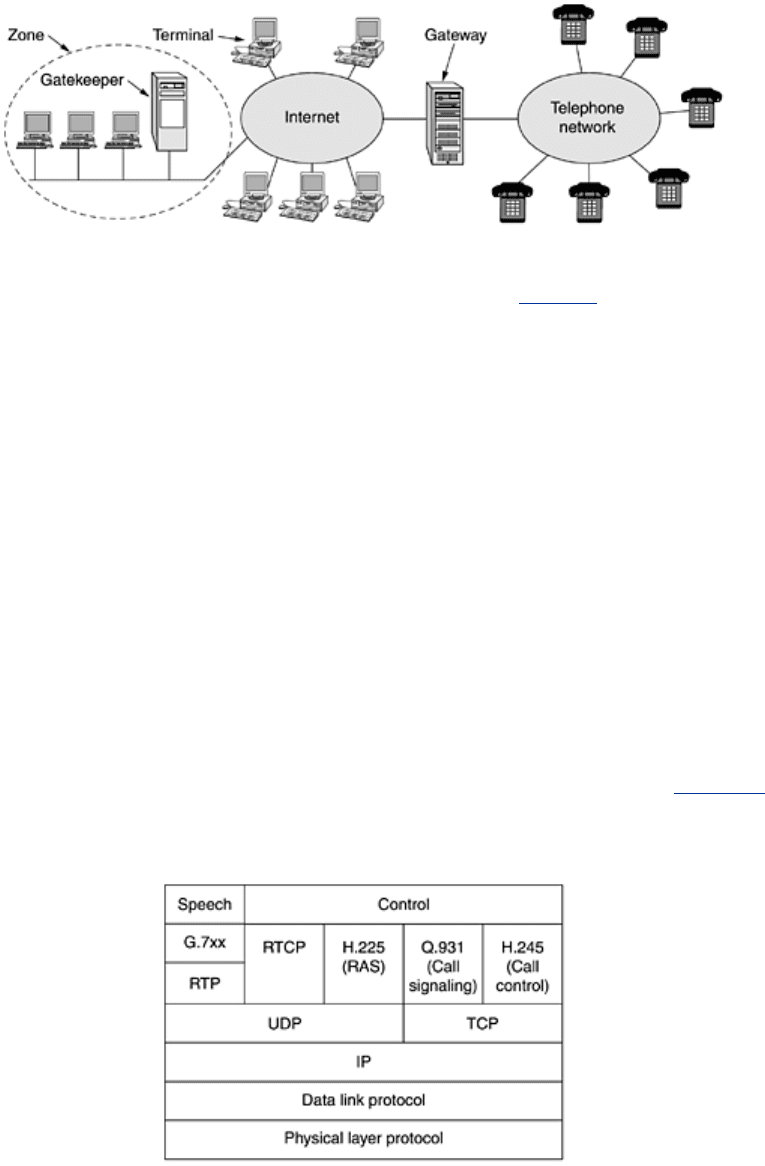
A telephone network needs a number of protocols. To start with, there is a protocol for
encoding and decoding speech. The PCM system we studied in
Chap. 2 is defined in ITU
recommendation
G.711. It encodes a single voice channel by sampling 8000 times per second
with an 8-bit sample to give uncompressed speech at 64 kbps. All H.323 systems must support
G.711. However, other speech compression protocols are also permitted (but not required).
They use different compression algorithms and make different trade-offs between quality and
bandwidth. For example,
G.723.1 takes a block of 240 samples (30 msec of speech) and uses
predictive coding to reduce it to either 24 bytes or 20 bytes. This algorithm gives an output
rate of either 6.4 kbps or 5.3 kbps (compression factors of 10 and 12), respectively, with little
loss in perceived quality. Other codecs are also allowed.
Since multiple compression algorithms are permitted, a protocol is needed to allow the
terminals to negotiate which one they are going to use. This protocol is called
H.245. It also
negotiates other aspects of the connection such as the bit rate. RTCP is need for the control of
the RTP channels. Also required is a protocol for establishing and releasing connections,
providing dial tones, making ringing sounds, and the rest of the standard telephony. ITU
Q.931 is used here. The terminals need a protocol for talking to the gatekeeper (if present).
For this purpose,
H.225 is used. The PC-to-gatekeeper channel it manages is called the RAS
(
Registration/Admission/Status ) channel. This channel allows terminals to join and leave
the zone, request and return bandwidth, and provide status updates, among other things.
Finally, a protocol is needed for the actual data transmission. RTP is used for this purpose. It is
managed by RTCP, as usual. The positioning of all these protocols is shown in
Fig. 7-65.
Figure 7-65. The H.323 protocol stack.
To see how these protocols fit together, consider the case of a PC terminal on a LAN (with a
gatekeeper) calling a remote telephone. The PC first has to discover the gatekeeper, so it
broadcasts a UDP gatekeeper discovery packet to port 1718. When the gatekeeper responds,
the PC learns the gatekeeper's IP address. Now the PC registers with the gatekeeper by
sending it a RAS message in a UDP packet. After it has been accepted, the PC sends the
gatekeeper a RAS admission message requesting bandwidth. Only after bandwidth has been
granted may call setup begin. The idea of requesting bandwidth in advance is to allow the
gatekeeper to limit the number of calls to avoid oversubscribing the outgoing line in order to
help provide the necessary quality of service.
531
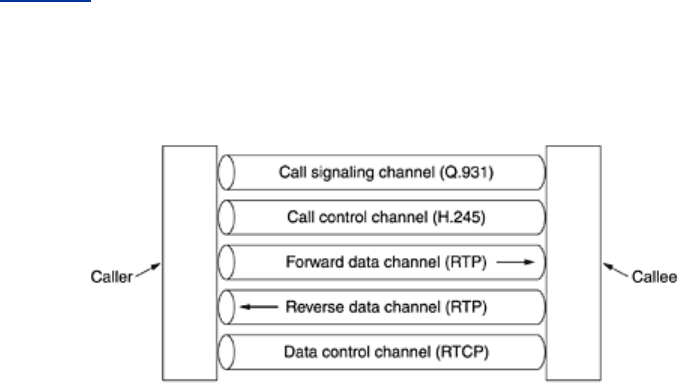
The PC now establishes a TCP connection to the gatekeeper to begin call setup. Call setup uses
existing telephone network protocols, which are connection oriented, so TCP is needed. In
contrast, the telephone system has nothing like RAS to allow telephones to announce their
presence, so the H.323 designers were free to use either UDP or TCP for RAS, and they chose
the lower-overhead UDP.
Now that it has bandwidth allocated, the PC can send a Q.931
SETUP message over the TCP
connection. This message specifies the number of the telephone being called (or the IP address
and port, if a computer is being called). The gatekeeper responds with a Q.931
CALL
PROCEEDING
message to acknowledge correct receipt of the request. The gatekeeper then
forwards the
SETUP message to the gateway.
The gateway, which is half computer, half telephone switch, then makes an ordinary telephone
call to the desired (ordinary) telephone. The end office to which the telephone is attached rings
the called telephone and also sends back a Q.931
ALERT message to tell the calling PC that
ringing has begun. When the person at the other end picks up the telephone, the end office
sends back a Q.931
CONNECT message to signal the PC that it has a connection.
Once the connection has been established, the gatekeeper is no longer in the loop, although
the gateway is, of course. Subsequent packets bypass the gatekeeper and go directly to the
gateway's IP address. At this point, we just have a bare tube running between the two parties.
This is just a physical layer connection for moving bits, no more. Neither side knows anything
about the other one.
The H.245 protocol is now used to negotiate the parameters of the call. It uses the H.245
control channel, which is always open. Each side starts out by announcing its capabilities, for
example, whether it can handle video (H.323 can handle video) or conference calls, which
codecs it supports, etc. Once each side knows what the other one can handle, two
unidirectional data channels are set up and a codec and other parameters assigned to each
one. Since each side may have different equipment, it is entirely possible that the codecs on
the forward and reverse channels are different. After all negotiations are complete, data flow
can begin using RTP. It is managed using RTCP, which plays a role in congestion control. If
video is present, RTCP handles the audio/video synchronization. The various channels are
shown in
Fig. 7-66. When either party hangs up, the Q.931 call signaling channel is used to
tear down the connection.
Figure 7-66. Logical channels between the caller and callee during a
call.
When the call is terminated, the calling PC contacts the gatekeeper again with a RAS message
to release the bandwidth it has been assigned. Alternatively, it can make another call.
We have not said anything about quality of service, even though this is essential to making
voice over IP a success. The reason is that QoS falls outside the scope of H.323. If the
underlying network is capable of producing a stable, jitterfree connection from the calling PC
532

(e.g., using the techniques we discussed in Chap. 5) to the gateway, then the QoS on the call
will be good; otherwise it will not be. The telephone part uses PCM and is always jitter free.
SIP—The Session Initiation Protocol
H.323 was designed by ITU. Many people in the Internet community saw it as a typical telco
product: large, complex, and inflexible. Consequently, IETF set up a committee to design a
simpler and more modular way to do voice over IP. The major result to date is the
SIP
(
Session Initiation Protocol), which is described in RFC 3261. This protocol describes how to
set up Internet telephone calls, video conferences, and other multimedia connections. Unlike
H.323, which is a complete protocol suite, SIP is a single module, but it has been designed to
interwork well with existing Internet applications. For example, it defines telephone numbers
as URLs, so that Web pages can contain them, allowing a click on a link to initiate a telephone
call (the same way the
mailto scheme allows a click on a link to bring up a program to send an
e-mail message).
SIP can establish two-party sessions (ordinary telephone calls), multiparty sessions (where
everyone can hear and speak), and multicast sessions (one sender, many receivers). The
sessions may contain audio, video, or data, the latter being useful for multiplayer real-time
games, for example. SIP just handles setup, management, and termination of sessions. Other
protocols, such as RTP/RTCP, are used for data transport. SIP is an application-layer protocol
and can run over UDP or TCP.
SIP supports a variety of services, including locating the callee (who may not be at his home
machine) and determining the callee's capabilities, as well as handling the mechanics of call
setup and termination. In the simplest case, SIP sets up a session from the caller's computer
to the callee's computer, so we will examine that case first.
Telephone numbers in SIP are represented as URLs using the
sip scheme, for example,
sip:ilse@cs.university.edu for a user named Ilse at the host specified by the DNS name
cs.university.edu. SIP URLs may also contain IPv4 addresses, IPv6 address, or actual
telephone numbers.
The SIP protocol is a text-based protocol modeled on HTTP. One party sends a message in
ASCII text consisting of a method name on the first line, followed by additional lines containing
headers for passing parameters. Many of the headers are taken from MIME to allow SIP to
interwork with existing Internet applications. The six methods defined by the core specification
are listed in
Fig. 7-67.
Figure 7-67. The SIP methods defined in the core specification.
To establish a session, the caller either creates a TCP connection with the callee and sends an
INVITE message over it or sends the INVITE message in a UDP packet. In both cases, the
headers on the second and subsequent lines describe the structure of the message body,
which contains the caller's capabilities, media types, and formats. If the callee accepts the call,
it responds with an HTTP-type reply code (a three-digit number using the groups of
Fig. 7-42,
533
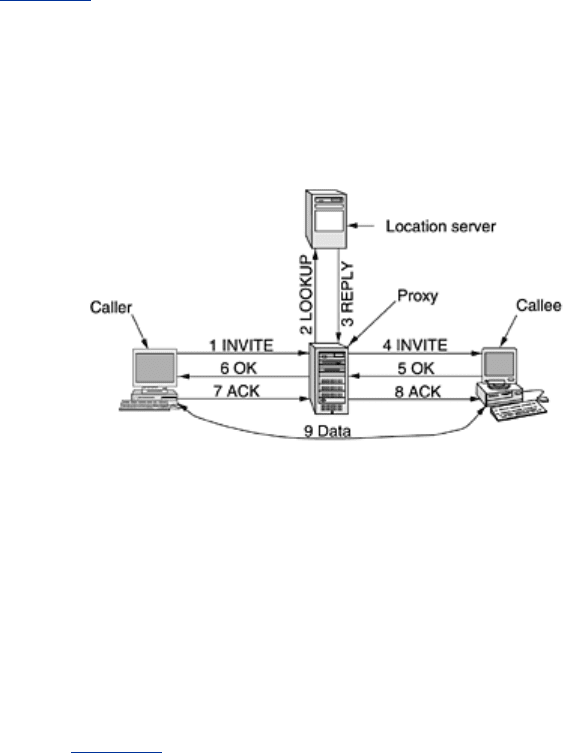
200 for acceptance). Following the reply-code line, the callee also may supply information
about its capabilities, media types, and formats.
Connection is done using a three-way handshake, so the caller responds with an
ACK message
to finish the protocol and confirm receipt of the 200 message.
Either party may request termination of a session by sending a message containing the
BYE
method. When the other side acknowledges it, the session is terminated.
The
OPTIONS method is used to query a machine about its own capabilities. It is typically used
before a session is initiated to find out if that machine is even capable of voice over IP or
whatever type of session is being contemplated.
The
REGISTER method relates to SIP's ability to track down and connect to a user who is away
from home. This message is sent to a SIP location server that keeps track of who is where.
That server can later be queried to find the user's current location. The operation of redirection
is illustrated in
Fig. 7-68. Here the caller sends the INVITE message to a proxy server to hide
the possible redirection. The proxy then looks up where the user is and sends the
INVITE
message there. It then acts as a relay for the subsequent messages in the three-way
handshake. The
LOOKUP and REPLY messages are not part of SIP; any convenient protocol can
be used, depending on what kind of location server is used.
Figure 7-68. Use a proxy and redirection servers with SIP.
SIP has a variety of other features that we will not describe here, including call waiting, call
screening, encryption, and authentication. It also has the ability to place calls from a computer
to an ordinary telephone, if a suitable gateway between the Internet and telephone system is
available.
Comparison of H.323 and SIP
H.323 and SIP have many similarities but also some differences. Both allow two-party and
multiparty calls using both computers and telephones as end points. Both support parameter
negotiation, encryption, and the RTP/RTCP protocols. A summary of the similarities and
differences is given in
Fig. 7-69.
Figure 7-69. Comparison of H.323 and SIP
534
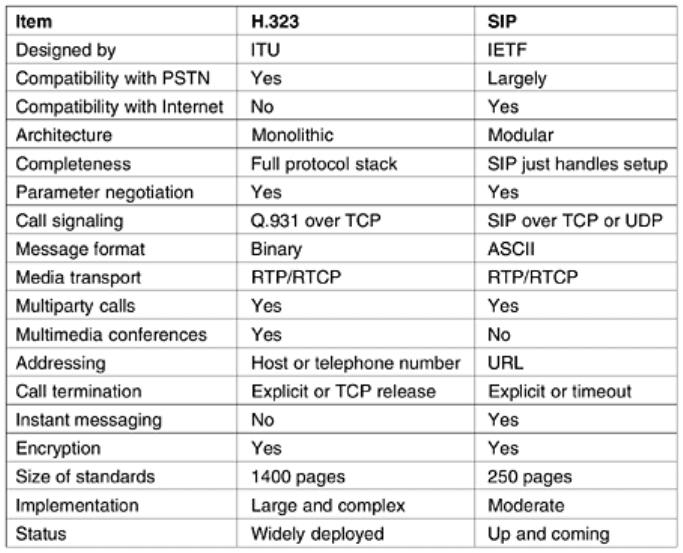
Although the feature sets are similar, the two protocols differ widely in philosophy. H.323 is a
typical, heavyweight, telephone-industry standard, specifying the complete protocol stack and
defining precisely what is allowed and what is forbidden. This approach leads to very well
defined protocols in each layer, easing the task of interoperability. The price paid is a large,
complex, and rigid standard that is difficult to adapt to future applications.
In contrast, SIP is a typical Internet protocol that works by exchanging short lines of ASCII
text. It is a lightweight module that interworks well with other Internet protocols but less well
with existing telephone system signaling protocols. Because the IETF model of voice over IP is
highly modular, it is flexible and can be adapted to new applications easily. The downside is
potential interoperability problems, although these are addressed by frequent meetings where
different implementers get together to test their systems.
Voice over IP is an up-and-coming topic. Consequently, there are several books on the subject
already. A few examples are (Collins, 2001; Davidson and Peters, 2000; Kumar et al., 2001;
and Wright, 2001). The May/June 2002 issue of
Internet Computing has several articles on this
topic.
7.4.6 Introduction to Video
We have discussed the ear at length now; time to move on to the eye (no, this section is not
followed by one on the nose). The human eye has the property that when an image appears
on the retina, the image is retained for some number of milliseconds before decaying. If a
sequence of images is drawn line by line at 50 images/sec, the eye does not notice that it is
looking at discrete images. All video (i.e., television) systems exploit this principle to produce
moving pictures.
Analog Systems
To understand video, it is best to start with simple, old-fashioned black-and-white television.
To represent the two-dimensional image in front of it as a one-dimensional voltage as a
function of time, the camera scans an electron beam rapidly across the image and slowly down
it, recording the light intensity as it goes. At the end of the scan, called a
frame, the beam
535

retraces. This intensity as a function of time is broadcast, and receivers repeat the scanning
process to reconstruct the image. The scanning pattern used by both the camera and the
receiver is shown in
Fig. 7-70. (As an aside, CCD cameras integrate rather than scan, but
some cameras and all monitors do scan.)
Figure 7-70. The scanning pattern used for NTSC video and television.
The exact scanning parameters vary from country to country. The system used in North and
South America and Japan has 525 scan lines, a horizontal-to-vertical aspect ratio of 4:3, and
30 frames/sec. The European system has 625 scan lines, the same aspect ratio of 4:3, and 25
frames/sec. In both systems, the top few and bottom few lines are not displayed (to
approximate a rectangular image on the original round CRTs). Only 483 of the 525 NTSC scan
lines (and 576 of the 625 PAL/SECAM scan lines) are displayed. The beam is turned off during
the vertical retrace, so many stations (especially in Europe) use this time to broadcast
TeleText (text pages containing news, weather, sports, stock prices, etc.).
While 25 frames/sec is enough to capture smooth motion, at that frame rate many people,
especially older ones, will perceive the image to flicker (because the old image has faded off
the retina before the new one appears). Rather than increase the frame rate, which would
require using more scarce bandwidth, a different approach is taken. Instead of the scan lines
being displayed in order, first all the odd scan lines are displayed, then the even ones are
displayed. Each of these half frames is called a
field. Experiments have shown that although
people notice flicker at 25 frames/sec, they do not notice it at 50 fields/sec. This technique is
called
interlacing. Noninterlaced television or video is called progressive. Note that movies
run at 24 fps, but each frame is fully visible for 1/24 sec.
Color video uses the same scanning pattern as monochrome (black and white), except that
instead of displaying the image with one moving beam, it uses three beams moving in unison.
One beam is used for each of the three additive primary colors: red, green, and blue (RGB).
This technique works because any color can be constructed from a linear superposition of red,
green, and blue with the appropriate intensities. However, for transmission on a single
channel, the three color signals must be combined into a single
composite signal.
When color television was invented, various methods for displaying color were technically
possible, and different countries made different choices, leading to systems that are still
incompatible. (Note that these choices have nothing to do with VHS versus Betamax versus
P2000, which are recording methods.) In all countries, a political requirement was that
programs transmitted in color had to be receivable on existing black-and-white television sets.
536

Consequently, the simplest scheme, just encoding the RGB signals separately, was not
acceptable. RGB is also not the most efficient scheme.
The first color system was standardized in the United States by the
National Television
Standards Committee
, which lent its acronym to the standard: NTSC. Color television was
introduced in Europe several years later, by which time the technology had improved
substantially, leading to systems with greater noise immunity and better colors. These systems
are called
SECAM (SEquentiel Couleur Avec Memoire), which is used in France and Eastern
Europe, and
PAL (Phase Alternating Line) used in the rest of Europe. The difference in color
quality between the NTSC and PAL/SECAM has led to an industry joke that NTSC really stands
for Never Twice the Same Color.
To allow color transmissions to be viewed on black-and-white receivers, all three systems
linearly combine the RGB signals into a
luminance (brightness) signal and two chrominance
(color) signals, although they all use different coefficients for constructing these signals from
the RGB signals. Oddly enough, the eye is much more sensitive to the luminance signal than to
the chrominance signals, so the latter need not be transmitted as accurately. Consequently,
the luminance signal can be broadcast at the same frequency as the old black-and-white
signal, so it can be received on black-and-white television sets. The two chrominance signals
are broadcast in narrow bands at higher frequencies. Some television sets have controls
labeled brightness, hue, and saturation (or brightness, tint, and color) for controlling these
three signals separately. Understanding luminance and chrominance is necessary for
understanding how video compression works.
In the past few years, there has been considerable interest in
HDTV (High Definition
TeleVision
), which produces sharper images by roughly doubling the number of scan lines.
The United States, Europe, and Japan have all developed HDTV systems, all different and all
mutually incompatible. Did you expect otherwise? The basic principles of HDTV in terms of
scanning, luminance, chrominance, and so on, are similar to the existing systems. However, all
three formats have a common aspect ratio of 16:9 instead of 4:3 to match them better to the
format used for movies (which are recorded on 35 mm film, which has an aspect ratio of 3:2).
Digital Systems
The simplest representation of digital video is a sequence of frames, each consisting of a
rectangular grid of picture elements, or
pixels. Each pixel can be a single bit, to represent
either black or white. The quality of such a system is similar to what you get by sending a
color photograph by fax—awful. (Try it if you can; otherwise photocopy a color photograph on
a copying machine that does not rasterize.)
The next step up is to use 8 bits per pixel to represent 256 gray levels. This scheme gives
high-quality black-and-white video. For color video, good systems use 8 bits for each of the
RGB colors, although nearly all systems mix these into composite video for transmission. While
using 24 bits per pixel limits the number of colors to about 16 million, the human eye cannot
even distinguish this many colors, let alone more. Digital color images are produced using
three scanning beams, one per color. The geometry is the same as for the analog system of
Fig. 7-70 except that the continuous scan lines are now replaced by neat rows of discrete
pixels.
To produce smooth motion, digital video, like analog video, must display at least 25
frames/sec. However, since good-quality computer monitors often rescan the screen from
images stored in memory at 75 times per second or more, interlacing is not needed and
consequently is not normally used. Just repainting (i.e., redrawing) the same frame three
times in a row is enough to eliminate flicker.
In other words, smoothness of motion is determined by the number of
different images per
second, whereas flicker is determined by the number of times the screen is painted per
537
second. These two parameters are different. A still image painted at 20 frames/sec will not
show jerky motion, but it will flicker because one frame will decay from the retina before the
next one appears. A movie with 20 different frames per second, each of which is painted four
times in a row, will not flicker, but the motion will appear jerky.
The significance of these two parameters becomes clear when we consider the bandwidth
required for transmitting digital video over a network. Current computer monitors most use the
4:3 aspect ratio so they can use inexpensive, mass-produced picture tubes designed for the
consumer television market. Common configurations are 1024 x 768, 1280 x 960, and 1600 x
1200. Even the smallest of these with 24 bits per pixel and 25 frames/sec needs to be fed at
472 Mbps. It would take a SONET OC-12 carrier to manage this, and running an OC-12 SONET
carrier into everyone's house is not exactly on the agenda. Doubling this rate to avoid flicker is
even less attractive. A better solution is to transmit 25 frames/sec and have the computer
store each one and paint it twice. Broadcast television does not use this strategy because
television sets do not have memory. And even if they did have memory, analog signals cannot
be stored in RAM without conversion to digital form first, which requires extra hardware. As a
consequence, interlacing is needed for broadcast television but not for digital video.
7.4.7 Video Compression
It should be obvious by now that transmitting uncompressed video is completely out of the
question. The only hope is that massive compression is possible. Fortunately, a large body of
research over the past few decades has led to many compression techniques and algorithms
that make video transmission feasible. In this section we will study how video compression is
accomplished.
All compression systems require two algorithms: one for compressing the data at the source,
and another for decompressing it at the destination. In the literature, these algorithms are
referred to as the
encoding and decoding algorithms, respectively. We will use this
terminology here, too.
These algorithms exhibit certain asymmetries that are important to understand. First, for many
applications, a multimedia document, say, a movie will only be encoded once (when it is stored
on the multimedia server) but will be decoded thousands of times (when it is viewed by
customers). This asymmetry means that it is acceptable for the encoding algorithm to be slow
and require expensive hardware provided that the decoding algorithm is fast and does not
require expensive hardware. After all, the operator of a multimedia server might be quite
willing to rent a parallel supercomputer for a few weeks to encode its entire video library, but
requiring consumers to rent a supercomputer for 2 hours to view a video is not likely to be a
big success. Many practical compression systems go to great lengths to make decoding fast
and simple, even at the price of making encoding slow and complicated.
On the other hand, for real-time multimedia, such as video conferencing, slow encoding is
unacceptable. Encoding must happen on-the-fly, in real time. Consequently, real-time
multimedia uses different algorithms or parameters than storing videos on disk, often with
appreciably less compression.
A second asymmetry is that the encode/decode process need not be invertible. That is, when
compressing a file, transmitting it, and then decompressing it, the user expects to get the
original back, accurate down to the last bit. With multimedia, this requirement does not exist.
It is usually acceptable to have the video signal after encoding and then decoding be slightly
different from the original. When the decoded output is not exactly equal to the original input,
the system is said to be
lossy. If the input and output are identical, the system is lossless.
Lossy systems are important because accepting a small amount of information loss can give a
huge payoff in terms of the compression ratio possible.
538
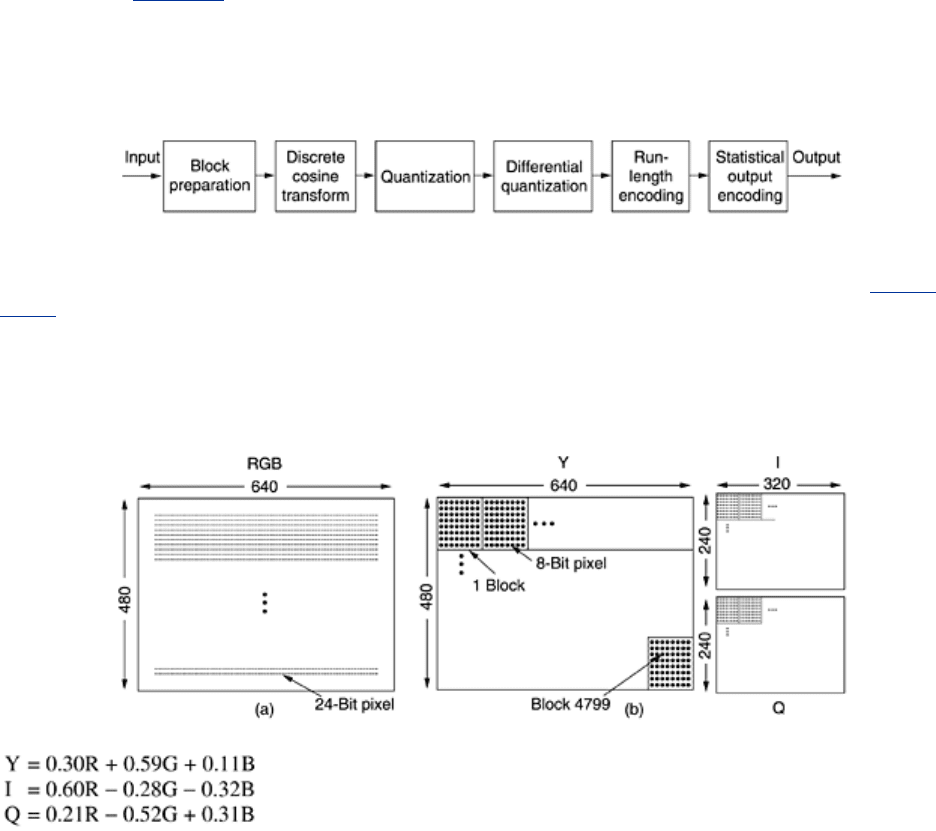
The JPEG Standard
A video is just a sequence of images (plus sound). If we could find a good algorithm for
encoding a single image, this algorithm could be applied to each image in succession to
achieve video compression. Good still image compression algorithms exist, so let us start our
study of video compression there. The
JPEG (Joint Photographic Experts Group) standard
for compressing continuous-tone still pictures (e.g., photographs) was developed by
photographic experts working under the joint auspices of ITU, ISO, and IEC, another standards
body. It is important for multimedia because, to a first approximation, the multimedia standard
for moving pictures, MPEG, is just the JPEG encoding of each frame separately, plus some
extra features for interframe compression and motion detection. JPEG is defined in
International Standard 10918.
JPEG has four modes and many options. It is more like a shopping list than a single algorithm.
For our purposes, though, only the lossy sequential mode is relevant, and that one is
illustrated in
Fig. 7-71. Furthermore, we will concentrate on the way JPEG is normally used to
encode 24-bit RGB video images and will leave out some of the minor details for the sake of
simplicity.
Figure 7-71. The operation of JPEG in lossy sequential mode.
Step 1 of encoding an image with JPEG is block preparation. For the sake of specificity, let us
assume that the JPEG input is a 640 x 480 RGB image with 24 bits/pixel, as shown in
Fig. 7-
72(a). Since using luminance and chrominance gives better compression, we first compute the
luminance,
Y, and the two chrominances, I and Q (for NTSC), according to the following
formulas:
Figure 7-72. (a) RGB input data. (b) After block preparation.
For PAL, the chrominances are called U and V and the coefficients are different, but the idea is
the same. SECAM is different from both NTSC and PAL.
539
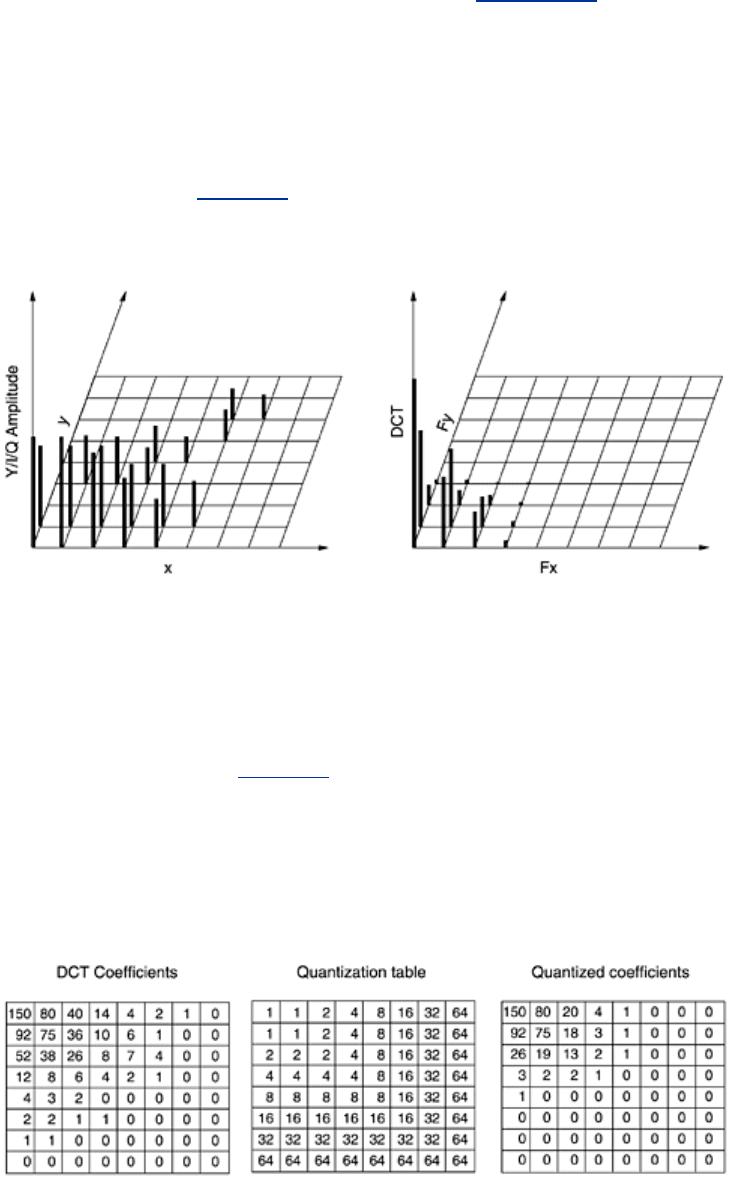
Separate matrices are constructed for Y, I, and Q, each with elements in the range 0 to 255.
Next, square blocks of four pixels are averaged in the
I and Q matrices to reduce them to 320
x 240. This reduction is lossy, but the eye barely notices it since the eye responds to
luminance more than to chrominance. Nevertheless, it compresses the total amount of data by
a factor of two. Now 128 is subtracted from each element of all three matrices to put 0 in the
middle of the range. Finally, each matrix is divided up into 8 x 8 blocks. The
Y matrix has 4800
blocks; the other two have 1200 blocks each, as shown in
Fig. 7-72(b).
Step 2 of JPEG is to apply a
DCT (Discrete Cosine Transformation) to each of the 7200
blocks separately. The output of each DCT is an 8 x 8 matrix of DCT coefficients. DCT element
(0, 0) is the average value of the block. The other elements tell how much spectral power is
present at each spatial frequency. In theory, a DCT is lossless, but in practice, using floating-
point numbers and transcendental functions always introduces some roundoff error that results
in a little information loss. Normally, these elements decay rapidly with distance from the
origin, (0, 0), as suggested by
Fig. 7-73.
Figure 7-73. (a) One block of the Y matrix. (b) The DCT coefficients.
Once the DCT is complete, JPEG moves on to step 3, called
quantization,in which the less
important DCT coefficients are wiped out. This (lossy) transformation is done by dividing each
of the coefficients in the 8 x 8 DCT matrix by a weight taken from a table. If all the weights are
1, the transformation does nothing. However, if the weights increase sharply from the origin,
higher spatial frequencies are dropped quickly.
An example of this step is given in
Fig. 7-74. Here we see the initial DCT matrix, the
quantization table, and the result obtained by dividing each DCT element by the corresponding
quantization table element. The values in the quantization table are not part of the JPEG
standard. Each application must supply its own, allowing it to control the loss-compression
trade-off.
Figure 7-74. Computation of the quantized DCT coefficients.
Step 4 reduces the (0, 0) value of each block (the one in the upper-left corner) by replacing it
with the amount it differs from the corresponding element in the previous block. Since these
540
